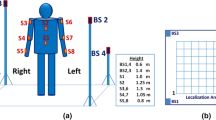Abstract
This paper deals with the positioning performance of the 3-Way ranging protocol (3-WR) in a wireless body area network (WBAN). The purpose is to propose a new cooperative algorithm to improve the number of estimated positions with a conditional permutation of the on-body anchors. To do so, we first evaluate and analyze the positioning success rate under a realistic mobility scenario and using two scheduling strategies: Broadcast single node localization (P2P-B) and aggregated and broadcast (A&B)) with a medium access control (MAC) layer based on time division multiple access (TDMA). The 3-WR estimates the distance between two nodes placed on the body with the transmission of three packets. The wireless transmission is based on impulse radio ultra wideband (IR-UWB). However, these transactions can be lost through the WBAN channel leading into a “bad positioning service.” We consider a physical layer based on IR-UWB with three different channels: (1) an empirical theoretical model based on the on-body CM3 path loss channel (Anechoic chamber), (2) a simulated channel calculated by ray-tracing with the PyLayers simulator, and (3) an experimental channel model obtained by measurements. Our results show that the channel affects the positioning success rate that decreases as a function of the sensitivity threshold at the receiver. This can be solved with long and short term analysis for the choice of virtual anchors to increase the positioning performance.











Similar content being viewed by others
References
Vicon. http://www.vicon.com/
Ben Hamida E, Alam M, Maman M, Denis B (2014) Short-term link quality estimation for opportunistic and mobility aware routing in wearable body sensors networks. In: 2014 IEEE 10th international conference on Wireless and mobile computing, networking and communications (wimob), pp 519–526. doi:10.1109/WiMOB.2014.6962220
Ben Hamida E, Maman M, Denis B, Ouvry L (2010) Localization performance in wireless body sensor networks with beacon enabled mac and space-time dependent channel model. In: 2010 IEEE 21st international symposium on Personal, indoor and mobile radio communications workshops (PIMRC workshops), pp 128–133. doi:10.1109/PIMRCW.2010.5670416
Cavallari R, Martelli F, Rosini R, Buratti C, Verdone R (2014) A survey on wireless body area networks: technologies and design challenges. IEEE Communications Surveys & Tutorials 16(3):1635–1657. doi:10.1109/surv.2014.012214.00007
Denis B, Amiot N, Uguen B, Guizar A, Goursaud C, Ouni A, Chaudet C (2014) Qualitative analysis of RSSI behavior in cooperative wireless body area networks for mobility detection and navigation applications. In: 21St IEEE international conference on electronics circuits and systems. Marseille, France
D’Errico R, Ouvry L (2010) A statistical model for on-body dynamic channels. Int J Wireless Inf Networks 17(3-4):92–104. doi:10.1007/s10776-010-0122-0
Guizar A, Ouni A, Goursaud C, Chaudet C, Gorce J (2015) Quantifying the impact of scheduling and mobility on IR-UWB localization in body area networks. In: 12Th IEEE international conference on body sensor networks. MIT, Cambridge
Hamie J, Denis B, D’Errico R, Richard C (2013) On-body toa-based ranging error model for motion capture applications within wearable UWB networks. Journal of Ambient Intelligence and Humanized Computing. doi:10.1007/s12652-013-0215-6
Hamie J, Denis B, Richard C (2014) Decentralized positioning algorithm for relative nodes localization in wireless body area networks. Mobile Networks and Applications 19(6):698–706. doi:10.1007/s11036-014-0543-6
Lauzier M, Ferrand P, Fraboulet A, Parvery H, Gorce J (2013) Full mesh channel measurements on body area networks under walking scenarios. In: 2013 7th european conference on Antennas and propagation (EuCAP), pp 3508– 3512
Macagnano D, Destino G, Esposito F, Abreu G MAC performances for localization and tracking in wireless sensor networks. In: 2007 4th Workshop on Positioning, Navigation and Communication. doi:10.1109/wpnc.2007.353649
Mhedhbi M, Amiot N, Avrillon S, Uguen B (2014) Human body perturbed antenna integration in indoor propagation simulator. In: Journées scientifiques 2014 de l’URSI France. paris, France. https://hal.archives-ouvertes.fr/hal-01122245
Moeslund TB, Hilton A, Krager V (2006) A survey of advances in vision-based human motion capture and analysis. Comput Vis Image Underst 104(2-3):90–126. doi:10.1016/j.cviu.2006.08.002
Sakaguchi T, Kanamori T, Katayose H, Sato K, Inokuchi S (1996) Human motion capture by integrating gyroscopes and accelerometers. 1996 IEEE/SICE/RSJ International Conference on Multisensor Fusion and Integration for Intelligent Systems (Cat no.96TH8242). doi:10.1109/mfi.1996.572219
Soganci H, Gezici S, Poor H (2011) Accurate positioning in ultra-wideband systems. IEEE Wirel Commun 18(2):19–27. doi:10.1109/mwc.2011.5751292
Wang L, Goursaud C, Nikaein N, Cottatellucci L, Gorce J (2013) Cooperative scheduling for coexisting body area networks. IEEE Trans Wirel Commun 12(1):123–133. doi:10.1109/TWC.2012.120412.112073
Xiao Z, Hei Y, Yu Q, Yi K (2010) A survey on impulse-radio UWB localization. Sci China Inf Sci 53(7):1322–1335. doi:10.1007/s11432-010-3102-1
Yang S, Lu JL, Yang F, Kong L, Shu W, Wu MY (2013) Behavior-aware probabilistic routing for wireless body area sensor networks. In: Global communications conference (GLOBECOM), 2013 IEEE, pp 444–449. doi:10.1109/GLOCOM.2013.6831111
Yazdandoost KY, Sayrafian-pour K (2009) Channel model for body area network (ban)
Acknowledgments
This work has been carried out in the frame of the CORMORAN project, which is funded by the French National Research Agency (ANR) under the contract number ANR-11-INFR-010. A part of this research has been realized at the LINCS laboratory. We thank all the involved researchers from ENS/IRISA and M2S Lab for their precious support during the measurement campaign.
Author information
Authors and Affiliations
Corresponding authors
Rights and permissions
About this article
Cite this article
Guizar, A., Goursaud, C. & Gorce, JM. Performance of IR-UWB cross-layer ranging protocols under on-body channel models with body area networks. Ann. Telecommun. 71, 453–463 (2016). https://doi.org/10.1007/s12243-016-0500-4
Received:
Accepted:
Published:
Issue Date:
DOI: https://doi.org/10.1007/s12243-016-0500-4




